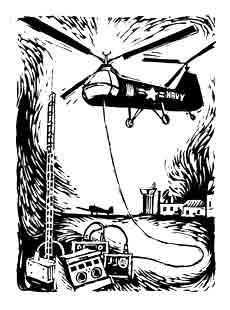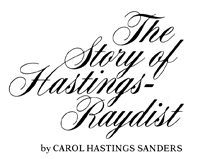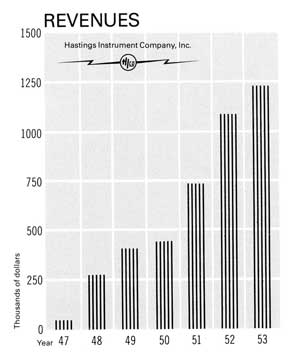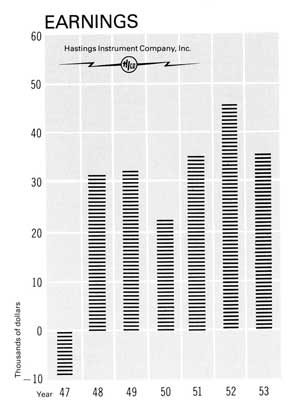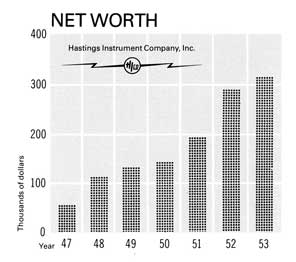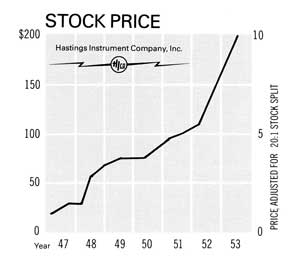T
he early 1950's were a heady period for the Hastings Instrument Company. Fueled by a strong demand for Raydist, the growth of the company was impressive. The outbreak of the Korean War brought large military contracts. In the commercial arena, Raydist was making great gains in hydrography, in ship testing, and in oil exploration. Sales of vacuum gauges, Air-Meters, and other instruments were improving, and new instruments were being introduced. Between 1950 and 1953, HICO's sales almost tripled, putting annual volume over a million dollars.
To meet these opportunities, the company embarked on an ambitious growth program. Not only did HICO grow, but two new organizations sprang up: Offshore Raydist, Inc., to supply Raydist services to the petroleum industry, and Raydist Navigation Corporation, to provide Raydist services outside the petroleum industry.
Someone who had not seen the Hastings Instrument Company since 1947 hardly would have recognized it six years later. In the summer of 1947 there were just under twenty employees working in cramped quarters at the Hastings home. By the summer of 1953 the number of employees had mushroomed to almost 200; they were spread out in three buildings with over 46,000 square feet of working space.
I
n 1948, when HICO moved to the plant on 39th Street, everyone had wondered how they would ever fill it up. But just a few years later they were looking for additional space. In 1951 Hastings Instrument Company bought a small, 1500-square-foot building adjacent to the main plant and filled it with the "Hastings Instrument" business—Air-Meters, vacuum gauges, and flowmeters.
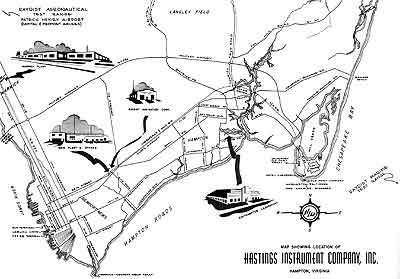
(click to enlarge)
|
|
In the early 1950's, expanding operations result in facilities at varied locations on the Peninsula.
|
The next step in the expansion was the July 1952 purchase of a 14,000 square foot building on Newcomb Avenue, in the Southampton area of Hampton. It became headquarters for research and engineering.
No sooner had they adjusted to this move when in December HICO bought a 17,000 square foot building on Main Street in Warwick and began to transfer all manufacturing operations there. The 39th Street plant was kept for administrative offices, and the small adjacent building was turned over to the newly formed Raydist Navigation Corporation.
F
inancing the explosive growth was not easy.
At the beginning of 1950 there had been 276 unsold shares of the original 3500. These were offered at $100 a share, with a 10 per cent discount to employees. By the end of the year, they were sold, raising $25,000, with all but 22 shares taken by employees.
Fortunately, the legal requirement that the number of stockholders remain below thirty was lifted at the end of 1950, when HICO paid its third dividend out of earned income in as many years. The company immediately laid plans for a public stock offering.
To raise capital without diluting control, the stockholders authorized the creation of two classes of stock: Class A shares, with voting rights, and Class B shares, without. The 3500 original shares of stock were exchanged for Class A shares at a rate of 20 new shares for each old share, thus accounting for 70,000 of the 80,000 Class A shares. The remaining 10,000 shares would be held by the corporation. Class B shares were to be sold as needed to raise cash.
During the Korean War, the Defense Production Administration encouraged the expansion of defense industries by granting accelerated depreciation on the cost of acquiring plants and equipment. In July 1951 Hastings Instrument Company received a Certificate of Necessity for $285,000 of expansion, allowing 80 per cent of the costs to be charged off in five years. To finance the expansion, Hastings Instrument Company applied to the Reconstruction Finance Corporation for a loan from the federal government of $275,650. The loan was just about ready for final signatures when Charles Hastings noticed several unsettling provisions. The most disturbing was a clause that the RFC could call the loan on thirty days notice if it found the management "unsatisfactory," even if HICO were not behind in its loan payments. Rather than agree to those terms, Hastings decided to scale down his expansion plans to $225,000 and finance his growth with bank loans, mortgages, the sale of Class B stock, and internally-generated cash.
In 1952 almost 9000 shares of Class B stock were sold at $6 a share, raising over $50,000.

Magazine ads are part of a program to recruit personnel.
|
M
ajor efforts went into enlarging the work force. Office and clerical personnel were recruited locally, but the search for technical people spread over the Southeast. Employment ads ran in major newspapers from Baltimore to Atlanta. Employment ads were also placed in technical journals such as Radio News and Electronics. Accompanied by an engineer to help with the interviews, Ray Doyle made recruiting trips to Norfolk, Virginia; Durham, North Carolina; Atlanta, Georgia; Knoxville, Tennessee; and Jacksonville, Florida.
To help him handle his expanding business, Charles Hastings brought in two men who had worked with him part-time for many years, to fill top positions.
The first of these was Jim Benson. Benson had worked part-time for the company ever since its beginning in 1944, and had served on the board of directors ever since its incorporation in 1947. Later in 1947 he had taken a leave of absence from the NACA to go back to the University of Tennessee to get his doctoral degree in physics. Although he lived in Tennessee for several years, he and Hastings kept in close touch. It was during those years that he and Hastings had developed the vacuum gauge.
Dr. Benson recalls: "In my spare time at the University of Tennessee I worked on vacuum gauges. I would design one and send the information to Charlie. He would get it built and send it back to me at Knoxville. I'd run tests on it there, and send back the results."
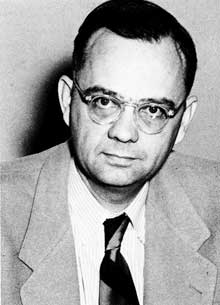
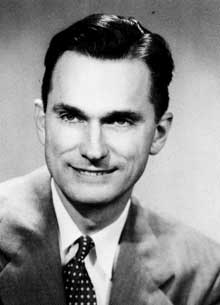
Two associates who have worked part-time with Hastings since the inception of the company leave the NACA in 1951 to accept full-time positions with HICO. James Benson (above) becomes director of research. Albert Budde (below) becomes treasurer and comptroller.
|
After receiving his Ph.D., Benson came back to Hampton to work for the NACA. A few months later, in February 1951, Hastings persuaded him to leave the NACA and become Vice-President and Director of Research with HICO.
A month later, Albert Budde followed Benson's lead. Like Benson, he was working full time at the NACA but had worked part time for HICO since its incorporation. He now became the company's treasurer. Later that year Budde was also put in charge of contract negotiations and liaison, freeing Andy Hacskaylo to become Assistant to the President.
S
ignificant changes were also made in the company's organization.
Charles Hastings had negotiated for years with various companies about a joint venture to supply Raydist services for the petroleum industry in the Gulf of Mexico. In 1951, HICO finally came to a satisfactory arrangement, creating Offshore Raydist, Incorporated. Half the ORI stock was owned by HICO. The other half was split equally between Offshore Navigation Corporation and Overseas Navigation Corporation, both headquartered in New Orleans. These other companies were owned and run by the same people, with one handling work in the Gulf of Mexico and the other handling worldwide petroleum survey operations. According to the agreement, HICO would supply Raydist equipment, technical know-how and the patent position, and the other companies would provide contacts, personnel, and financing.
The bulk of ORI's work, at least in the beginning, was in the Gulf. The main competition was Seismograph Service Corporation, which had brought out a system called Lorac.
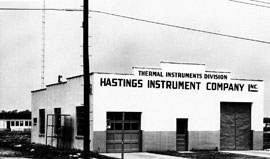
From 1951 to 1953, Hastings Instruments, often referred to during this period as "thermal instruments," occupies a building adjacent to the main plant on 39th Street.
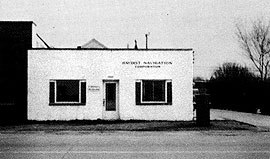
At first RNC rents space in a small building across the street from the 39th Street plant. Later it expands to approximately a dozen employees and takes over the building formerly used by "thermal" instruments.
|
Raydist Navigation Corporation came to life in 1951. It had originally been chartered in 1949, with the expectation that it would handle the leasing of Raydist systems in the Gulf of Mexico. When the dispute over the tidelands brought a halt to oil explorations in the Gulf, there was no immediate reason to complete the organization and financing of the new corporation. It lay dormant until 1951.
By then the work in the petroleum industry was being turned over to ORI. RNC was set up to handle the leasing of Raydist equipment and personnel and the sale of production models of Raydist equipment outside the petroleum industry. RNC bought all its Raydist equipment from Hastings Instrument Company, and HICO continued to handle research, development, and manufacture of Raydist and other instruments, as well as the sale of custom-designed Raydist equipment. The two companies shared the same management.
There were several reasons for setting up RNC as a separate corporation. The main one centered on the enormous overhead expenses involved with HICO's cost-plus-fixed-fee development contracts. Separating the functions allowed a more accurate allocation of overhead, and enabled RNC, not burdened with excess overhead, to be more competitive in the commercial field.
In addition, having two corporations lowered the total amount of excess-profits taxes that would be due, made it easier to have separate personnel policies for the two very different types of operations, and made it possible to borrow more money from banks before reaching their legal limits.
RNC operated for a year as a wholly-owned subsidiary. It became an independent corporation in late 1952, when its shares were distributed as a dividend to the stockholders of HICO.
T
he bulk of the attention in the early fifties was focused on Raydist, and of all the jobs Raydist did in this period, none was more important than its use in the trial tests of the S. S. United States. These were years when Raydist was continually trying to establish itself in new fields, and the story of getting and performing this job reflects the types of difficulties and triumphs that were part of this process.
Charles Hastings had laid the groundwork for this job back in 1947. At the time, John Comstock, Mary's father, was Assistant Naval Architect at Newport News Shipbuilding and Drydock Company, and the shipyard was hoping to build the S. S. United States. The superliner promised to be the fastest passenger liner in the world, and would serve as a troop transport in the event of war. Eventually Comstock would be in charge of hull design for the ship, but in 1947 he was a member of the Shipyard Research Committee, whose duties included advising the shipyard as to the best way to conduct the ship's trial tests.
Comstock believed that his son-in-law's equipment offered great promise for trial tests. Trying not to appear to be just pushing the family business, he suggested to the committee that it investigate the possibility of running the trial tests with Raydist. If the system worked, it would be far superior to the traditional method of conducting the tests at a measured-mile course.
The committee agreed, and in November 1947 asked Hastings to make a proposal. He did, and as the proposal sounded plausible, they agreed to keep it in mind.
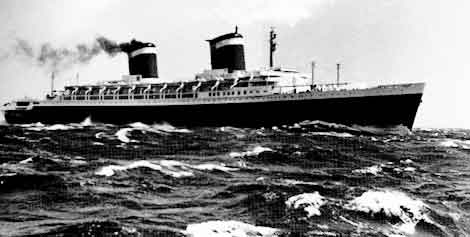
S. S. United States
|
In November 1949 Newport News Shipbuilding was awarded the contract. The ship would be ready for trials in May 1952. The decision about Raydist would be made shortly before the trials.
According to the Hastings proposal, the tests would use a specially-designed buoy that could be cast overboard and allowed to float freely during the trials. The relay equipment would be installed in the buoy, while the United States would carry the master station. Raydist would then record the liner's speed as it steamed directly towards or away from the buoy.
In November 1951 Hastings arranged a demonstration of his system for the shipyard's top officials. For this test, the master set was installed on a shipyard tug and the relay equipment was placed on a moored barge. The tug then proceeded up and down a measured course of approximately a mile in front of the shipyard.
The data came in all right at first, but then a strange irregularity was noticed. No one knew what was causing it. Hastings thought perhaps they were getting phase distortions caused by the steel hulls of two large ships—one of them the United States herself—tied up at nearby shipyard piers.
To check this out, the master station was transferred to the pilot house of the United States and the buoy apparatus was transferred to the tug, which then made several passes close behind the moored liner to watch the effects of passing by the hull of a large ship. This data tended to confirm the Hastings theory.
Then the tug proceeded up the James River to test maximum range of the equipment.
The demonstration was not an unqualified success. The system had not been as accurate as had been hoped, it was subject to phase distortions, and the range was less than half of what Hastings had expected on the basis of his earlier experiments.
But Hastings was not about to lose the job. After the tests he sat down with the officials in the lounge of the tug determined to convince everyone there that Raydist could do the job. The accuracy problems, he argued, were not the fault of Raydist—they could be explained by the tug, which had not followed a perfectly straight course, and the barge, which could swing on its moorings. On an actual trial, there wouldn't be phase distortions caused by the hulls of other ships, because there wouldn't be any large ships nearby. The limited range could be attributed to poor location of the antennas on the tug. Whatever the objection, Hastings had an answer.
The shipyard officials weren't entirely convinced by these explanations. On the other hand, they were very much aware of the limitations of measured-mile courses and of the advantages of the electronic approach.
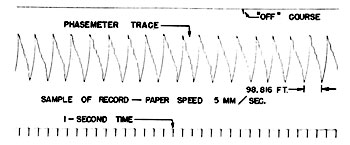
Strip recording of speed data
|
If Raydist could do the job, they would reap enormous benefits. The tests could be run in deep water just off the Atlantic Shelf, about a hundred miles east of the shipyard. Otherwise the ship would have to travel over 1000 miles to Guantanamo Bay, Cuba, the nearest measured-mile course able to handle a ship as large and fast as the United States. Since the costs of trial tests, including crew salaries, ran around $100,000 a day, saving time was very important. A Raydist test would allow unlimited sea room to maneuver, while the measured-mile courses were cramped and restricting. With Raydist, there would be no need to correct for currents or tides, for the buoy would be affected by the same currents as the ship. Good visibility was not necessary. It would be possible to make tests of any length, not just one mile, and in any direction, into, across, and with the wind. The system could measure accelerations and turns, which the measured-mile courses could not do at all. And as a bonus, Raydist would enable the speed trial information to be kept secret from unauthorized persons. This feature was particularly appealing in the case of the United States. Because she might one day be used as a troop transport, her maximum speed was classified information. If she were tested at a measured-mile course, it would be relatively easy for anyone on the ship or on the beach nearby to get that information.
They concluded that the Raydist project should be continued.
With this hurdle behind him, Hastings continued to improve his equipment while the shipyard designed a buoy to be as free as possible from the effects of wind and waves.
Before Raydist could get final approval, however, Hastings would have to prove to both the shipyard and the U.S. Maritime Administration that the accuracy of the speed measurements obtained by Raydist was equal to or better than that from a measured-mile course.
The next demonstration was held the following February in the upper Chesapeake Bay at Kent Island, the closest measured-mile course. It was a do-or-die demonstration for Raydist, witnessed not only by the shipyard and the U.S. Maritime Administration, but also by the ship's architect, the U.S. Coast Guard, the Bureau of Standards, and the David Taylor Model Basin.
This time the demonstration went well. Raydist made the grade and was approved for use on the United States trials. With one proviso. The shipyard was not about to put all its eggs into the Raydist basket. The United States would go to sea for her tests with provisions on board for a trip to Guantanamo Bay. If Raydist failed, she would proceed there and complete her tests in the time-honored manner.
For the tests aboard the United States, plans called for two complete Raydist systems, operating at different frequencies. If all went well, the data from one would duplicate the data from the other. If one system failed, the other would at least get sufficient data. If both failed …
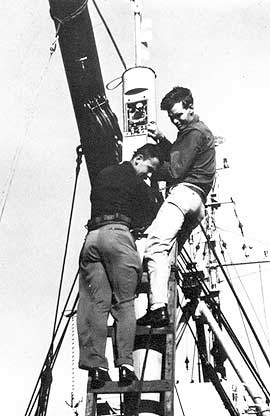
Bob Cayouette and Floyd Gibbs tune Raydist buoy as it sits on the deck of the Coast Guard Cutter Conifer.
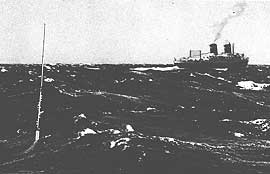
Freefloating buoy (left foreground) with Raydist antenna attached is affected by the same water currents as the United States.
|
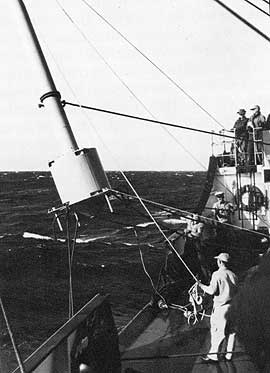
Buoy is lowered from the deck of the Conifer prior to the trial tests.
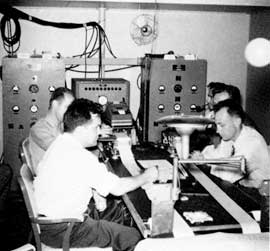
Two complete Raydist systems are set up in the officers' lounge of the S. S. United States. Charles Hastings (left foreground) and Allen Comstock (right foreground) are part of the Raydist team analyzing the data. Others present are Jimmy Dale, Bob Courtney, and Andy Hacskaylo.
|
By May 14, when the United States was ready to leave for her trials, her officers' lounge sported two complete Raydist master stations, and her aft deck carried a spare Raydist-equipped buoy. The two main buoys were aboard the U.S. Coast Guard Cutter Conifer, which would accompany the liner and be in charge of launching and retrieving the buoys.
The voyage got off to an auspicious beginning. The weather was good, and the crews of both ships looked forward to a placid voyage. The United States and the Conifer headed out for a rendezvous point 120 miles off the Virginia Capes.
That evening the two ships made a preliminary test of the Raydist equipment, with the buoys still on the deck of the Conifer. Everything seemed to be working satisfactorily. As evening turned to night, however, the wind picked up, and soon gale force winds of 50 miles an hour were blowing over the ship and creating 20-foot waves. The effect of the wind and waves on the 990-foot liner was minimal, but the 180-foot cutter found itself tossed around so severely that first its bow and then its rudder were completely out of the water. The scourge of seasickness descended.
The next morning it became the task of a seasick crew to launch the two 42-foot buoys weighing a ton apiece from a pitching deck awash with sea water. Their difficulties caused a three-hour delay, but at last the buoys were launched successfully.
The tests began. Thirteen times the captain of the liner held his engines at a given horsepower for a six-mile run while Raydist measured the speed of the liner at that engine output. On all but a part of one run Raydist did its job without a hitch. The one slip came when the liner was steaming directly into the wind, so that the combined speed of the liner and the wind gave a relative wind speed of 78 knots. A Raydist antenna blew overboard, and the Raydist crew had to switch the equipment to another antenna before they could continue their recordings.
By the end of the day their tests were complete, and the Raydist crew was jubilant. Their data had been accepted by the Trial Board of the Maritime Administration, and would be recommended for acceptance by the Bureau of Standards. With this support, getting Raydist used for future trial tests would require less of a selling job.
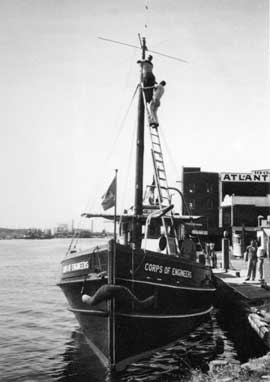
The Norfolk Corps of Engineers bought its first Raydist system in 1950. Here, Raydist technicians install an antenna on the Pocahontas. (1951)
|
As far as the Newport News Shipyard was concerned, Raydist had proved its case. From then on, all their trial tests used it. And almost immediately Hastings began to receive inquiries from other shipyards. Less than two months later, his crew was doing a similar job for the shipyard of Bethlehem Steel at Quincy, Massachusetts. Within a few years, Raydist dominated the sea trial business in the United States.
As for the United States, the ship was indeed the fastest passenger liner in the world. Her top speed on the trials, no longer classified, was 38.32 knots, and she set a record on her maiden voyage by crossing the Atlantic in 3 days, 10 hours, and 40 minutes, at an average speed of 35.59 knots.
E
qually as important as ship trials to the company's growth, were Raydist gains in hydrography and oil prospecting.
The sale of Raydist to the Norfolk Corps of Engineers in 1950 set the stage for great progress in the hydrographic field. Extremely pleased with their results, the Norfolk Corps gave Raydist good publicity. An article about their work soon appeared in the Military Engineer and was reprinted in the International Hydrographic Review. It stated:
A complete hydrographic survey was made and maps prepared of an area covering 1 1/2 square miles during two days operation, as compared to the seven to eight days which would have been required using customary methods.
The place of Raydist as a hydrographic tool was assured.
Early in 1951 the U.S. Naval Hydrographic Office recommended Raydist to a delegation from the Portuguese Navy studying U.S. hydrographic techniques, and in March 1951 HICO made its first foreign Raydist sale—a set to be used in charting the waters off Mozambique in southeast Africa.
Lt. Commander J. S. Brito, in charge of the operations in Mozambique, wrote to Hastings:
I will tell you the campaign was a very good one. The area surveyed in a four month operation was superior to 5500 square miles, more than we have done in the two previous years. The equipment had only a few faults and it was a remarkable achievement. The greater part of Sofala Bank is now surveyed and we hope to finish it next year.
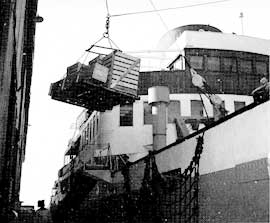
In 1952 the Portuguese Navy buys a second Raydist system, for use in Portuguese Guinea. Here the system is being loaded aboard a freighter at the C&O pier in Newport News.
|
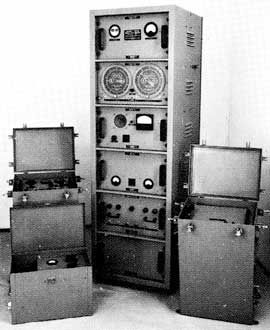
Type N Raydist sold to the Portuguese Navy.
|
In the Gulf of Mexico, Raydist was gaining a good reputation with the petroleum industry. Almost immediately after Offshore Raydist was formed in 1951, nine Raydist survey crews were working around- the-clock for six major oil companies exploring for offshore oil deposits. Raydist stations were set up from Alabama to Texas, blanketing the Gulf with Raydist signals.
In the spring of 1953 President Eisenhower signed a bill giving the states the rights to the tidelands out to their traditional offshore boundaries. Therefore oil companies would negotiate their leases with states rather than the federal government. With that issue settled, prospecting in the Gulf of Mexico grew rapidly, and Raydist was in on the ground floor of this important modern industry.
A
lthough ship testing, hydrography, and oil prospecting eventually became the bread and butter of Raydist operations, in the early 1950's most Raydist work still involved cost-plus-fixed-fee development contracts with various branches of the military.
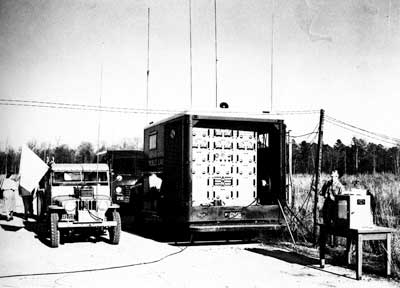
Jeep used in Raydist demonstration of all-weather landing system for Wright Field sits beside truck containing Raydist master station.
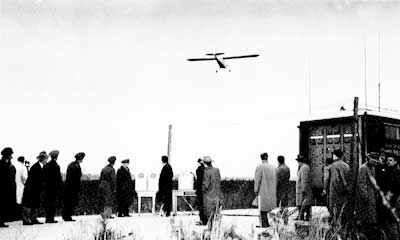
Piper Cub flies overhead as military and civilian spectators watch Raydist track its position.
|
In 1951, HICO completed a Raydist system for the All Weather Flying Division of the Air Force. It was to be used at Wright-Patterson Air Force Base in Dayton, Ohio, to test the accuracy of radar and other blind landing systems.
A demonstration of the system was held for Wright-Patterson officials at Patrick Henry Field in February. Using the opportunity to promote Raydist to other military and civilian government agencies, Hastings invited over twenty other high-ranking military and civilian officials to observe the demonstration.
First, a jeep, equipped with a Raydist transmitter and carrying a flag for clear observation, drove around on the runways while Raydist tracked its position. Next Raydist tracked a Piper Cub as it circled one end of the airport.
Later that year HICO built an automatic plotting board to supplement the Raydist system at Wright-Patterson Air Force Base. Again, the demonstration of the finished product was a big event. The highlight of this demonstration came when the board plotted a plane's path as it performed skywriting maneuvers spelling HICO across the sky.
A
nother major project was the development of a miss distance indicator for the Navy Bureau of Ordnance.
The Navy wanted to train men to shoot ground-to-air missiles at targets. By recording the distance by which each missile missed the target, a miss distance indicator would help the men improve their accuracy. It could also enable them to practice without destroying the targets, for instead of aiming to hit the targets, they could aim to miss them by a given distance.
The system HICO developed put a radio transponder in each missile and in each airborne target. The transponder in the target transmitted signals to and received signals from the missile as it approached the target. At the missile's closest point in passing by the target, the signals provided a measure of the distance between the two objects, thereby indicating the distance by which the missile missed the target.
Even though the development of the system was successful, the final product never got beyond the preliminary testing stage. Developed at a time when transistors and other solid state electronic devices had not yet come into wide use, the miss distance indicator was designed with vacuum tubes. Immediately afterwards, a tremendous upheaval in electronic design rendered almost all equipment based on vacuum tubes obsolete.
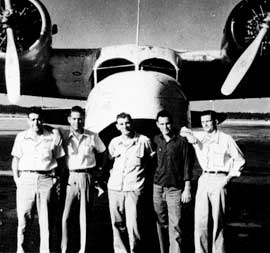
In the winter of 1951-52, Raydist makes an electronic survey of the Bahama Islands. The results of the survey show the distances between various islands. Here are five members of the crew, and their chartered Grumman Goose airplane.
|
I
n 1951 a Raydist crew went to the Bahama Islands to survey distances for a U.S. Air Force missile proving ground. Measuring the distances required setting up Raydist base stations on remote islands, then tracking an airplane as it flew between islands.
For the nine Raydist men who were sent out on the project, it was a rugged job. The crew and equipment left from Miami on a converted banana boat. Once in the Bahamas, the boat dropped off a base station and a crew member at each island to be surveyed. Sometimes the man would have to live alone on an island for two or three weeks at a time, attending his base station, until that part of the survey was complete. When the sea was too rough for food to be brought to him by boat, C rations were dropped by plane.
Raydist turned in a stellar performance. Before coming to Hastings, the Air Force had spent two years and $6,000,000 in a futile attempt to get the job done using Shoran. Now Raydist had come in and done the job in four months for only $120,000.
D
uring the winter, air masses from the Pacific Ocean sweep across the Sierra Nevada mountains of California and often form "standing waves" in the Owens Valley, which lies between the Sierra Nevadas and the Inyo Mountains. These waves delighted sailplane enthusiasts and aroused the curiosity of scientists. In the winter of 1951-52, the Sierra Wave project, a program to study this intriguing meteorological phenomenon, hired Raydist to provide continuous position data of sailplanes during flight.
As soon as a wave formed, a sailplane was sent up, equipped with a Raydist transmitter and instruments to measure air speed, altitude, barometric pressure, and temperature. Five Raydist relay stations received the radio signals from both the sailplane and a reference transmitter on the ground. The resulting audio beat notes were sent over telephone lines to the Raydist master station. There, the signals from the relay stations were analyzed to determine the three-dimensional position of the sailplane.
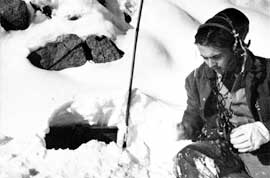
In charge of Raydist at the Sierra Wave project, Bob Cayouette sits in snow to check a Raydist relay station.
|
Here was a job on the outer fringes of Raydist's abilities. Both collecting and reducing the data were extraordinarily difficult. First, the successful operation of Raydist requires knowing the speed of propagation of radio waves, and the speed is not constant in mountainous terrain. Operating in the mountains is the antithesis of operating over large bodies of salt water, the ideal Raydist environment. Second, the mathematics of working with the hyperbolic line-of-position patterns was formidable enough in two dimensions in the days before computers—working in three dimensions complicated the analysis still more. On a more mundane level, snowslides were a problem, as were jackrabbits, who liked to chew the telephone wires in half during the middle of a mission.
Another problem was that at this time Raydist equipment did not provide lane identification. It told the user that he was on one of the equal phase lines, or how far from one, but not which one. The distance between one equal phase line and the next was known as a lane. To get around the problem of no lane identification, the Raydist user set the equipment to a known position before a job was started. From this point on, as long as nothing upset the count, the Raydist equipment counted lanes automatically as they were crossed and identified the plane's position down to 1/100th of a lane. Since lanes were typically 150 feet wide, this was high accuracy indeed. But if something upset the lane count, the Raydist user was in a position similar to that of a person trying to tell time with a clock that had a very accurate minute hand but no hour hand.
Under the circumstances, it was not surprising that the results were less than perfect. In many cases a loss of Raydist lane count prevented an accurate tracking of the aircraft. Still, the project collected valuable velocity and acceleration data. And it gave Bob Cayouette, the Raydist engineer in charge of the project, some ideas which would one day lead to the solution of the problem of lane identification.
A
lthough Raydist was being successful in many new fields, there were disappointments as well. It was a time of expanding horizons, taking chances, and hoping for a good batting average. Some opportunities that looked promising, in retrospect turned out not to be so.
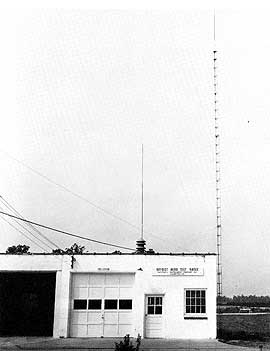
Raydist Aero Test Range occupies a corner of a building at Patrick Henry Field. (1953)
|
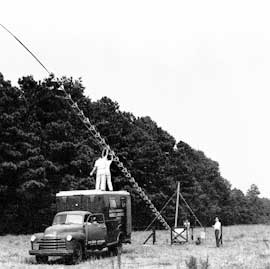
A relay station for the test range is set up nearby at Yoder's Dairy (1953)
|
In 1953, Hastings Instrument Company set up a Raydist Aeronautical Test Range at Patrick Henry Airport and equipped it with a three-dimensional automatic tracking system. The idea was that the aircraft industry and government agencies needed a way to test aircraft quickly and with a minimum of red tape. Planes could fly in, quickly undergo speed or other tests, and immediately fly out again.
Unfortunately, sufficient business for the test range was not forthcoming, and it was discontinued a few years later.
I
n November 1952 a crowd of 5000 gathered for a birthday celebration honoring the third anniversary of the local airport, Patrick Henry Field. A highlight of the program was a Raydist demonstration of blind landing of helicopters.
Raydist engineers set up a Raydist master station at the airport and a transmitter in a Coast Guard helicopter. When it was time for the demonstration to begin, a Coast Guard cadet placed two nickels on a far runway. The location of the coins was known to Allen Comstock, the Raydist engineer in charge of the demonstration, but not to the helicopter pilot.
Comstock, seated so that he couldn't see the helicopter, radioed instructions to the pilot using only the information provided by the Raydist dials. Meanwhile, the public could watch both the helicopter and a duplicate set of the Raydist position dials Comstock was watching.
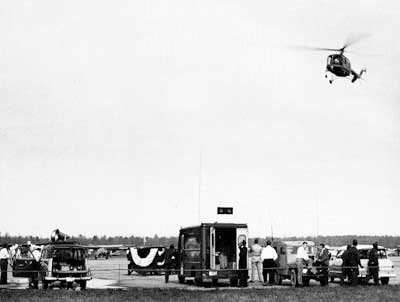
In November 1952 Raydist demonstrates its ability to provide blind landings for helicopters.
|
The helicopter took off. Following Comstock's directions, the pilot guided it toward the coins on the far runway.
"You are approaching the spot," Comstock told him. "To the left five feet … back to the right one foot … easy now. Set her down right there. The coins should be directly under you now."
They were—so close that the pilot didn't even have to get out of the cockpit to pick them up.
The following August, Hastings invited officials from various government agencies and aviation companies to Patrick Henry Field to watch a demonstration showing the applicability of Raydist to the navigation and all-weather operation of helicopters.
Three months later, HICO and RNC sponsored a joint demonstration with Piasecki Helicopter Corporation, which was looking for a way to make a helicopter hover at a given position and altitude by remote control. To accomplish this, Raydist data was fed into the aircraft's autopilot.
Charles Hastings hoped that these successful demonstrations would be a prelude to completely automatic controlled flights for helicopters used in aerial mapping, mail delivery, rescue work, and landings in fog-bound airports. But as impressive as these performances were, the time was not yet ripe for major practical applications of Raydist on helicopters. Transistors had not yet replaced vacuum tubes, and accordingly a complete Raydist system was still too large and too heavy to install in a helicopter. The lack of lane-identification prevented Raydist's being used for navigation. In addition, much of the experimental helicopter work was being financed under military development contracts, and in another year HICO would stop accepting such contracts.
Combining the advantages of helicopters and Raydist would have to wait. And when the time came, the uses would be along other lines than Charles Hastings had envisioned.
C
ompared with Raydist, the Hastings instruments accounted for a small percentage of HICO's business during the early 1950's. The most important of these products was the Air-Meter, but the line also included vacuum gauges, flowmeters, accelerometers, and an electronic standard cell.
Up until 1953, the company maintained a low-key sales program for the instruments. It mailed out notices of new products to a small mailing list, and occasionally it placed magazine advertisements. Primarily it submitted information to the "New Product News Releases" columns of technical magazines, which published information on new products at no charge. As a result of these programs, sales had built up to about $70,000 per year.
In the spring of 1953 Ray Doyle was put in charge of instrument sales. He suggested that HICO do what many other small companies did—set up a manufacturer's representative program. He wasn't familiar with all the details of what was typically done, but he did know that each representative was given an exclusive territory and was paid a commission on all orders that came in from that territory. To Charles Hastings that idea seemed quite unfair. He was in favor of paying a commission on all orders a sales rep generated, but was adamant that he wouldn't pay commissions on unsolicited sales.
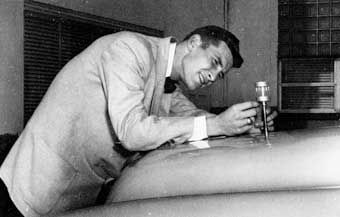
Charlie Hawk examines Air-Meter probe on the hood of the HICO station wagon.
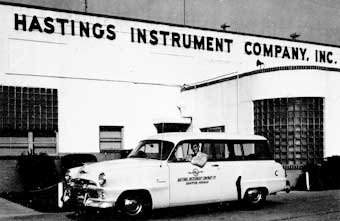
Hawk sets off to line up manufacturer's representatives.
|
By fall HICO was no farther along toward getting good nationwide distribution than it had been in the spring. They had mentioned the problem to J. Branch Briggs, the advertising agency in Philadelphia that was handling their magazine ads, and the men at Briggs also suggested that a manufacturer's representative program might be the best way to go. They themselves weren't very familiar with these programs, but one of the artists at the agency had a brother-in-law who was one, and they would see if they could get him to meet with them and discuss how the system worked.
Meanwhile, assuming HICO did set up such a program, who would be in charge of it? Certainly not Ray Doyle, for he was already in charge of all of production and couldn't go off around the country signing up representatives.
Still wondering who might be able to handle a job like that, Charles and Mary Hastings asked Ray and Ellen Doyle to join them at a local production of the musical comedy "Anything Goes."
On stage as the leading man was Raydist engineer Charles Hawk, playing the role of the brash, determined, energetic, go-getter hero Billy Crocker. Mary turned to Charles and said, "You know that person we're looking for to set up the instrument sales—why not Charlie Hawk? He looks the part."
The Hastingses talked it over with Ray Doyle, and a couple of days later Hawk was offered the job. He was willing to give it a try, and soon the four of them were in Philadelphia, discussing with manufacturer's rep Tyler Griffin the details of how such programs worked. Griffin explained the importance of exclusive territories to the group, and Charles Hastings was persuaded that if he didn't go along with that system he wouldn't get the caliber of representative he wanted.
Although he wasn't especially enthusiastic about the prospects for their instruments, Tyler Griffin liked the HICO people. He agreed to accept the line at least temporarily, and volunteered to take Hawk with him on a few calls in the Philadelphia area to show him the routine.
Soon Hawk was outfitting the station wagon he would call home for the next year. He filled the back with instruments on shock mounts, and put in a power supply so that the instruments could be run off the station wagon's battery. He mounted a wind velocity probe in the center of the hood and connected it to a recorder in the back—he would be able to make an excellent demonstration of the Air-Meter by driving down the highway.
Then, armed with a directory of U.S. manufacturer's representatives, Hawk took to the road.
A
long with its other activities, HICO kept its eye out for electronic opportunities in new fields.
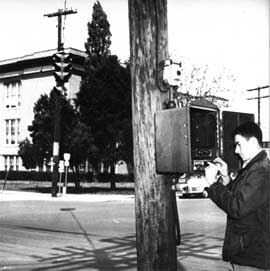
A Hampton city electrician makes final adjustments on the HICO instrument for tripping traffic lights. Only the small piece of equipment in the bottom of the control box is the Hastings device. (1953)
|
An interesting one presented itself in December 1952. Virginia's highest court, the Supreme Court of Appeals, ruled that it was illegal for drivers of emergency vehicles to go through red lights. The driver of a fire truck, police car, or ambulance who disregarded traffic signals was personally liable for any damage that resulted. This caused an uproar around the state, as emergency vehicles followed the ruling, sometimes doubling the time required to answer a call.
Charles Hastings and James Benson got together and came up with an idea for an electronic device similar to a garage door opener by which emergency vehicles could control the lights at each intersection they passed. A radio signal transmitter installed on the vehicle would send out signals to receivers installed in traffic light control boxes. Hastings and Benson estimated that receivers on the light control boxes would cost about $50 each, and transmitters, about $25 each. The signals would be coded to prevent unauthorized persons from using the system for their own amusement.
Their proposal received a lot of publicity. A prototype was built and installed at the traffic light at the intersection of Victoria Boulevard and Kecoughtan Road.
But the proposal came to naught when the legislature reconvened in January and decided to change the law to relieve drivers of liability. This made Virginia like other states. Then, as in other states, most cities decided that systems to change traffic lights for emergency vehicles weren't worth the cost.
In a different vein, HICO landed a Navy contract to develop a digital computer for shipboard use that would require much less power than other computers. It was a major contract in itself, and also opened up the possibility that HICO would get into the computer field. As it turned out, the computer was one of the last digital computers ever designed for vacuum tubes. Like the miss distance indicator, the computer was made obsolete almost immediately by the advent of solid-state electronics.
Upon consideration, HICO decided not to pursue computers. The company's capital was extremely limited, and it appeared foolish to invest it in an area where HICO had no patent position and would be facing well-financed, heavy competition.
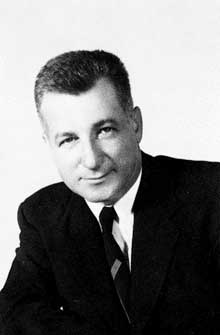
Arthur Samet becomes General Manager of Raydist Navigation Corporation in 1953.
|
A
s 1953 drew to a close, Charles Hastings could look back with pride on the accomplishments his companies had made in so few years. Sales for HICO in 1953 were almost triple those of 1950. After-tax earnings would have increased proportionately, except that the rapid five-year depreciation being taken on the new buildings and equipment was making reported earnings artificially low.
The management team was working well. There had been one serious loss earlier that year, when Andy Hacskaylo left to become a partner in a family-owned hosiery business. In addition to his other duties, Andy had served as HICO's secretary since 1948. But on the positive side, Ray Doyle assumed Andy's duties as secretary, and Arthur Samet, who was on the board of directors and had worked part-time for the company since 1946, left the NACA in April 1953 to come to work full time as general manager of Raydist Navigation Corporation.
As Hastings looked ahead, he was optimistic about the prospects. He saw Raydist coming into use as a general navigation system. He had great hopes for the new range Raydist system that was just about to be introduced. And he looked forward to a nationwide network of manufacturer's representatives bringing vastly increased instrument sales.
But he also saw several clouds on the horizon.
Seismograph Service Corporation was suing him. In October 1952, Gulf Oil Corporation, which had been using Lorac, the Seismograph system, ran a comparison test with Raydist. On the basis of the test, Gulf switched to Raydist. Two weeks later, Seismograph filed suit against Offshore Raydist and Hastings Instrument Company for patent infringement. It charged that both the Honoré patent (to which Seismograph had exclusive rights) and a patent filed by Dr. James Hawkins, head of Seismograph's research and development, were being infringed. Hastings had filed a counter suit, alleging patent infringement by Seismograph. He also claimed that because of the confidential negotiations that had occurred between Seismograph and Hastings in 1946, there was a constructive trust on Seismograph for the benefit of Hastings with respect to either or both of the Honoré and Hawkins patents. The trial would come up next year.
In addition, the company's problems with government cost-plus-fixed-fee contracts seemed to be getting worse instead of better. In a memo describing some of the problems, Hastings noted: "Whereas once I thought of these contracts as a 'can't lose' proposition, now I fear that perhaps they should be avoided like a plague."
A few months before, he had told a government inspector at his company that unless the situation improved he would refuse to do cost-plus government work.
"This company can't survive without government research and development contracts," the inspector replied haughtily.
"The hell it can't!" Hastings shot back.
Maybe it would soon come to that, Hastings thought. In any case, 1954 promised to be an interesting year.
next chapter >>
Copyright © by Carol Hastings Sanders
|
